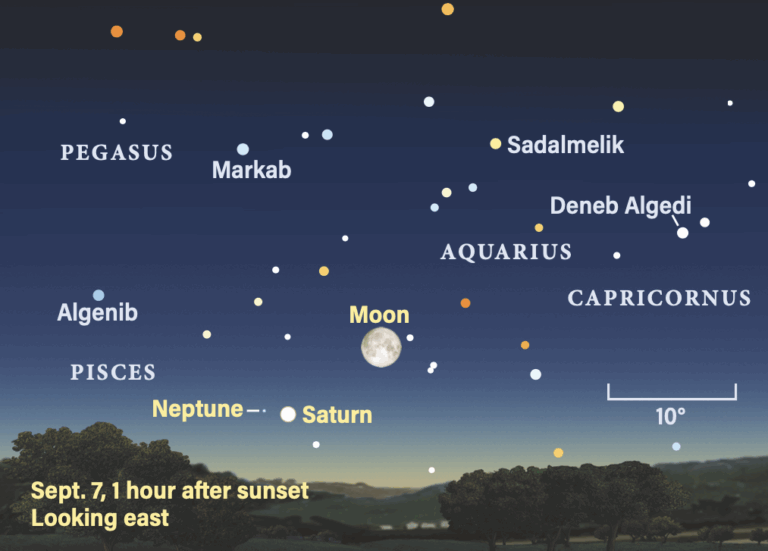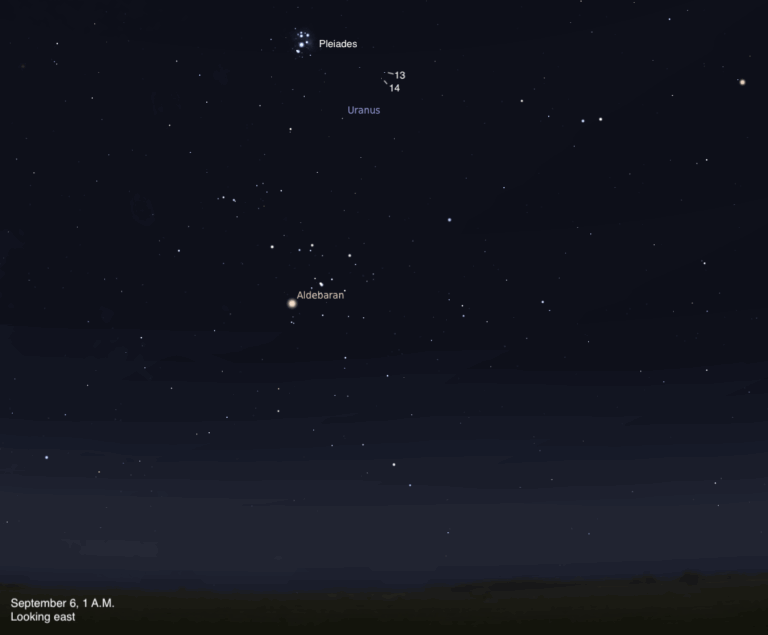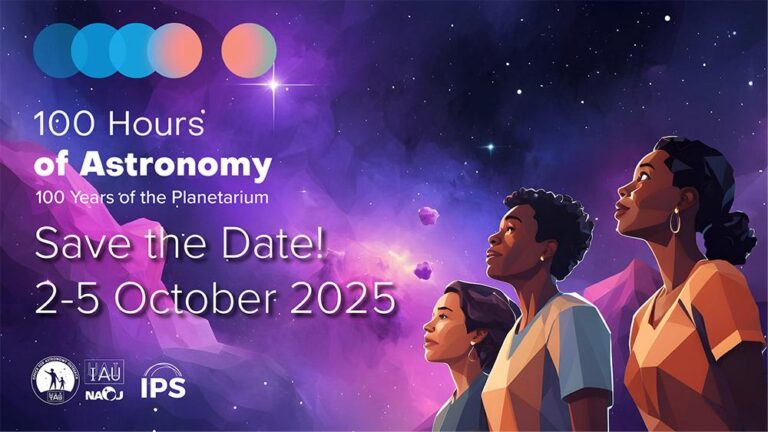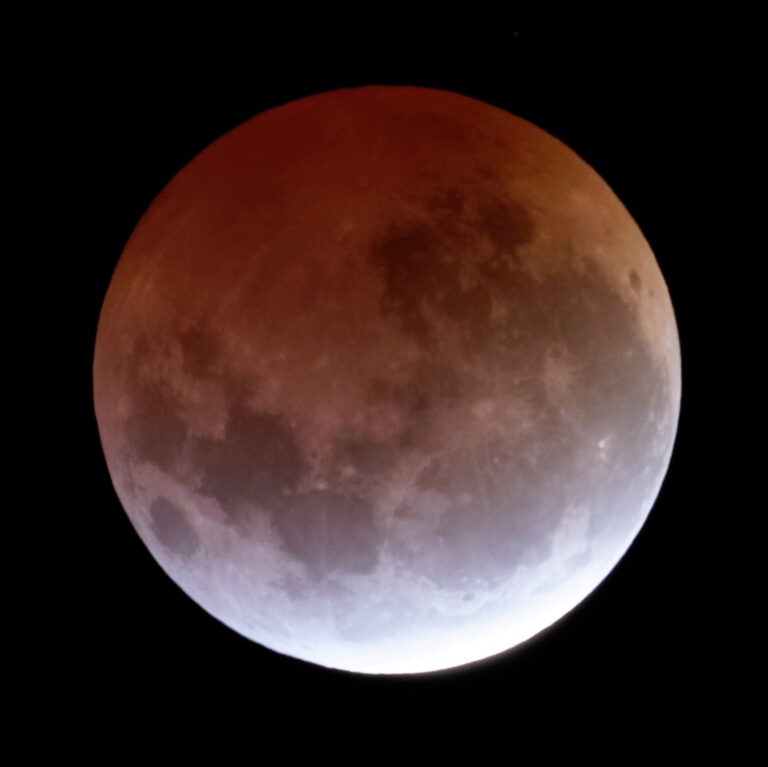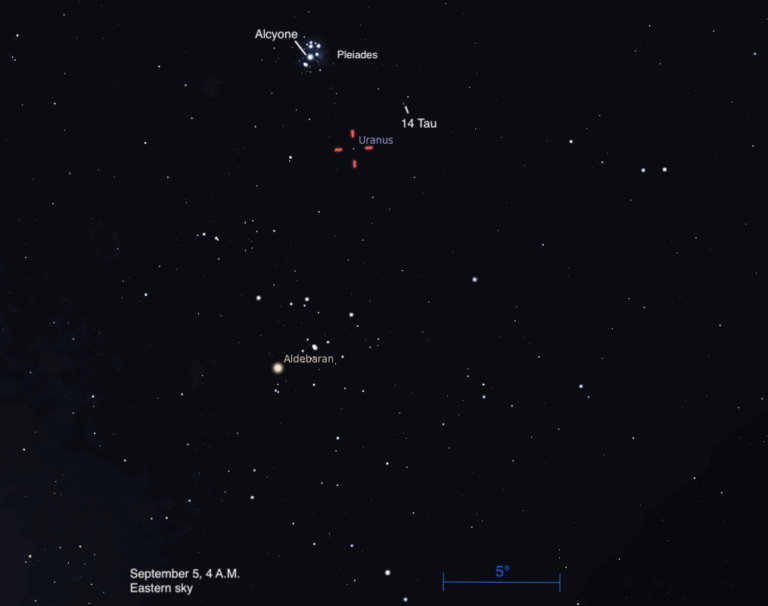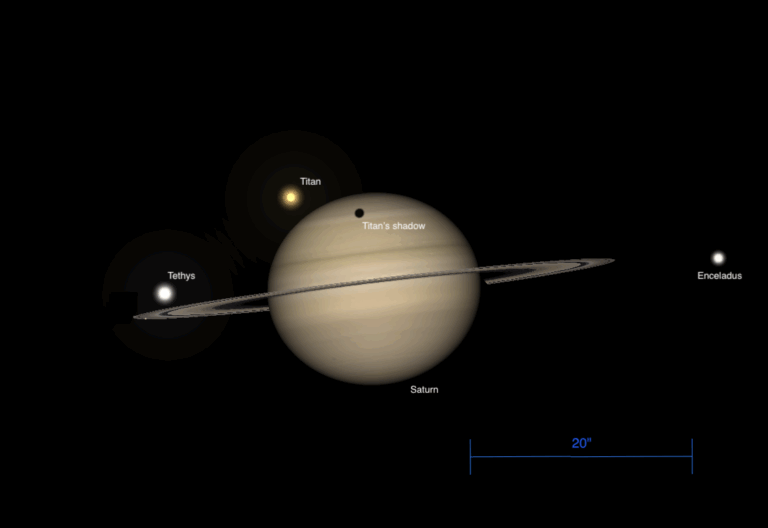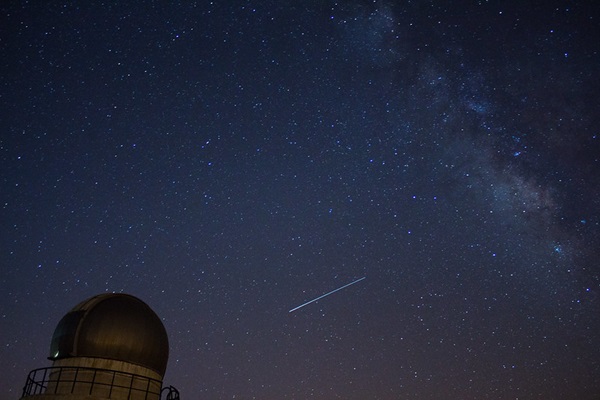
Key Takeaways:
Friday, April 21
The Moon passes 1.7° north of Uranus at 9 A.M. EDT. A few hours later, Mercury reaches its stationary point at noon EDT.
By sunset, the Moon has moved farther afield, sitting roughly halfway between the pair of Uranus and Mercury (which hang close together near the western horizon) and Venus, which lies higher up in Taurus.
Let’s start near the horizon. About 30 minutes after sunset, magnitude 1.9 Mercury is just over 7° high. You may need binoculars or a small telescope to spot its faint light against the falling twilight, or you can give the sky more time to darken — just note that the planet will sink lower as more time passes. Once you’ve found it, you can use Mercury as a springboard to Uranus, which lies just under 4° to the planet’s east-southeast. At magnitude 5.9, the distant ice giant is extremely faint and won’t appear to the naked eye, even as darkness falls.
Look up to find the slim crescent Moon, just 4 percent lit as it begins to wax from New. Only a small sliver of its eastern limb is illuminated. Keep looking up and you’ll run into unmissable Venus, blazing at magnitude –4.1. It lies about 8° north of Aldebaran, Taurus’ red giant eye. The 1st-magnitude star will be one of the first to appear as twilight deepens. See how long it takes for you to spot it to Venus’ lower left in the sky. The Pleiades, a famous young star cluster, lie some 12.5° to Venus’ lower right (west); similarly, see how long it takes before its blue-white stars begin to appear after sunset.
Take particular note of the positions of the Moon and Venus — they’ll draw closer as the week progresses, so we’ll return to this pair in just a few days.
Sunrise: 6:13 A.M.
Sunset: 7:45 P.M.
Moonrise: 6:59 A.M.
Moonset: 9:48 P.M.
Moon Phase: Waxing crescent (3%)
*Times for sunrise, sunset, moonrise, and moonset are given in local time from 40° N 90° W. The Moon’s illumination is given at 12 P.M. local time from the same location.

Saturday, April 22
The Lyrid meteor shower peaks overnight, offering viewing opportunities late tonight and early tomorrow morning as Lyra climbs higher in the sky. The constellation is marked by the bright star Vega, which shines at magnitude 0 and is one of the three points that make up the Summer Triangle asterism.
The Lyrids appear to originate from a radiant about 8° to the upper right (west) of Vega as it rises. This point lies about one-third of the way between Vega and 3rd-magnitude Sarin in Hercules. Once you’ve found the area, however, you’ll want to look away from it to the north or south. The farther from the radiant you look, the longer meteor trails will appear as shower members streak across the sky.
The Lyrids’ peak will only bring about 18 meteors per hour, while the radiant’s position and the waxing Moon will bring that number down a bit more. However, if the weather is fair, it’s certainly worth stepping outside late tonight or early Sunday morning a few hours before dawn to see if you can catch a few bright shooting stars in the sky.
Sunrise: 6:12 A.M.
Sunset: 7:46 P.M.
Moonrise: 7:32 A.M.
Moonset: 10:57 P.M.
Moon Phase: Waxing crescent (7%)
Sunday, April 23
The Moon passes 1.3° north of Venus at 9 A.M. EDT; by sunset this evening, our satellite lies to Venus’ upper left and the two are just over 5° apart. The Moon’s eastern side is slowly seeing more sunlight; it’s now a 16-percent-lit waxing crescent in the falling twilight.
Through a telescope, Venus appears nearly 70 percent lit and stretches some 16″ across. As the stars begin to appear in the sky, look to the east in Gemini and you’ll discover Mars creating the apex of an upside-down triangle anchored by the bright stars Castor and Pollux, the Twins’ heads. Mars is now magnitude 1.2 and just 6″ across. Some 20° to its left (southeast) is the bright star Procyon, the standout luminary in Canis Minor the Little Dog. This magnitude 0.3 sun is the sky’s eighth-brightest star — it’s unsurprisingly a close one, too, just over 11 light-years away.
Like its counterpart Sirius in Canis Major, Procyon also has a dim, tiny white dwarf companion. Although technically within the range of most telescopes — it’s magnitude 10.8 — this stellar remnant is more than 15,000 times fainter than Procyon A, which simply overwhelms its light. Thus, the white dwarf Procyon B is exceedingly difficult to spot; it’s best to simply consider that when you look at the light from this bright star, you’re also seeing the contribution from its diminutive companion.
Sunrise: 6:11 A.M.
Sunset: 7:47 P.M.
Moonrise: 8:10 A.M.
Moonset: —
Moon Phase: Waxing crescent (14%)
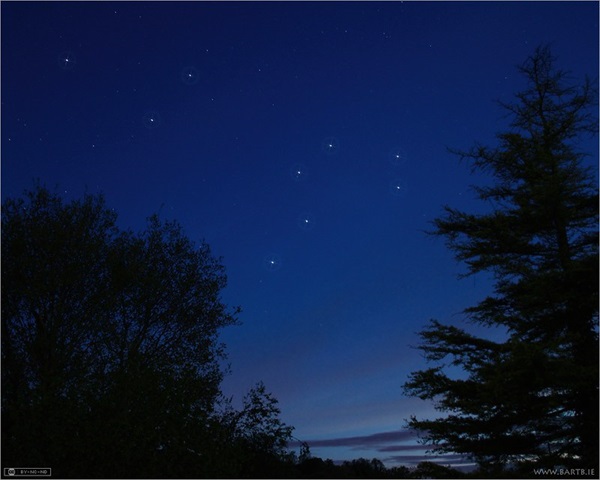
Monday, April 24
Asteroid 4 Vesta, the second-most massive body in the main belt, reaches conjunction with the Sun at 5 A.M. EDT. While this means it’s not visible, the No. 1 body in the belt, 1 Ceres, is readily visible this evening near the tail of Leo the Lion.
After dark, look south for the Sickle of Leo, a pattern of six stars that starts with the Lion’s brightest star, Regulus, at the bottom of the handle and ends with 3rd-magnitude Epsilon (ϵ) Leonis at the tip of the hook. Many observers think of it as a backwards question mark on the sky. Once you’ve found it, look left (east) down the Lion’s body for the tip of his tail: This is 1st-magnitude Denebola. Ceres lies 3.5° east-northeast of this star, in a region relatively devoid of bright background stars. The magnitude 7.5 dwarf planet should be relatively easy to identify with binoculars or a telescope — you can use the chart in April’s Sky This Month to guide you.
Next, move back to the Sickle for a bonus target: The galaxy NGC 2903 lies some 4° west-southwest of Epsilon (ϵ) Leonis. This 9th-magnitude galaxy can be challenging in some binoculars, but its oval-shaped glow should show up in larger pairs or through a more powerful telescope.
Sunrise: 6:09 A.M.
Sunset: 7:48 P.M.
Moonrise: 8:55 A.M.
Moonset: 12:01 A.M.
Moon Phase: Waxing crescent (21%)
Tuesday, April 25
The Moon continues along the ecliptic, passing 3° north of Mars at 10 P.M. EDT. The two are in roughly that position by sunset and an hour after the Sun disappears, they remain some 50° high in the west, hanging below 1st-magnitude Castor and Pollux.
Also setting in the west this evening is one of the largest asterisms in the sky. Now that spring has sprung, the wintertime constellations are disappearing as darkness falls, including the Winter Hexagon. It is anchored by six bright stars, all still visible above the horizon for an hour or two after. Start above the Moon and Mars at Pollux, the leftmost (eastern) Twin’s head. From there, move clockwise to Capella in Auriga, Aldebaran in Taurus, Rigel in Orion, Sirius in Canis Major, and Procyon in Canis Minor, finally closing the loop back at Pollux.
The Winter Hexagon encloses a huge area of sky that contains many rich treasures, including several bright nebulae and clusters. Soon, these stars will set at the same time or even before the Sun and the summertime constellations will fully rule the sky from dusk ‘till dawn.
Sunrise: 6:08 A.M.
Sunset: 7:49 P.M.
Moonrise: 9:48 A.M.
Moonset: 12:58 A.M.
Moon Phase: Waxing crescent (30%)
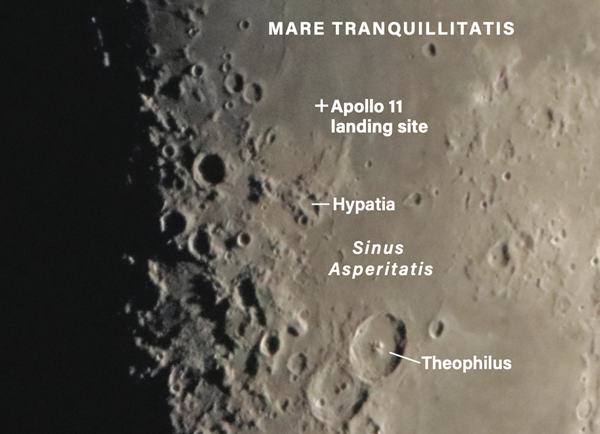
Wednesday, April 26
The Moon’s rugged, airless surface goes through profound visual changes as Luna waxes and wanes. From our viewpoint, the changing Sun angle induces an ever-morphing landscape as light spills over mountains, plains, and crater rims.
Recently, Astronomy columnist Stephen James O’Meara discussed the ray of sunlight that spreads across the floor of Hypatia Crater when the Sun reaches just the right height above the region.
Hypatia is located on the southwestern rim of the large Sea of Tranquillity — in fact, it sits just south of the famous Apollo 11 landing site, at the edge of a feature called Sinus Asperitatis or the Bay of Roughness. A breach in Hypatia’s eastern wall allows light from the rising Sun to flood the crater floor as the lunar day proceeds. You can see for yourself tonight — the Sun is expected to reach the right height above the lunar surface on April 27 03h30m UT, which is 11:30 P.M. EDT on April 26 (tonight).
To catch the event, set up your telescope well in advance and locate Hypatia. Then, settle in to wait, watching the crater’s dark floor for the ray to appear.
Sunrise: 6:07 A.M.
Sunset: 7:50 P.M.
Moonrise: 10:45 A.M.
Moonset: 1:47 A.M.
Moon Phase: Waxing crescent (39%)
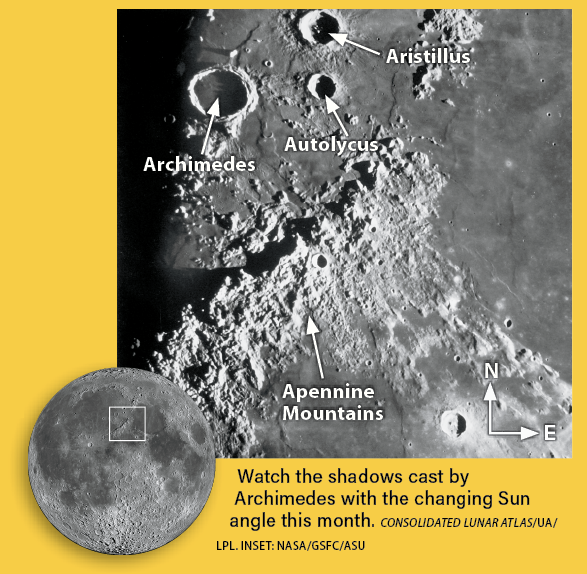
Thursday, April 27
First Quarter Moon occurs at 5:20 P.M. EDT. That makes tonight the perfect time to travel back to the Moon, now located in Cancer, with your telescope to enjoy the shadows cast by the rugged Apennine mountains that separate the Sea of Serenity from the large Imbrium basin.
The terminator now appears to split Luna right down the middle. Look just north of the equator for the well-rounded western rim of the Sea of Serenity. To its southwest lie the Apennines, which cut just below the barely visible rims of the craters Archimedes, Autolycus, and Aristillus. The Apennines rise some 1 to 3 miles (2 to 5 kilometers) high and were likely formed when the impact that excavated Imbrium interacted with what were likely already complex geological features in the area.
Trace your way along the mountain chain, then zoom in on Archimedes’ flat floor to the north. Can you see the saw-toothed shadows just starting to creep across it? The later in the evening you look, the more likely they are to appear as the increasing sunlight creeps across the surface, illuminating more of the Moon.
Sunrise: 6:05 A.M.
Sunset: 7:51 P.M.
Moonrise: 11:46 A.M.
Moonset: 2:27 A.M.
Moon Phase: Waxing crescent (48%)
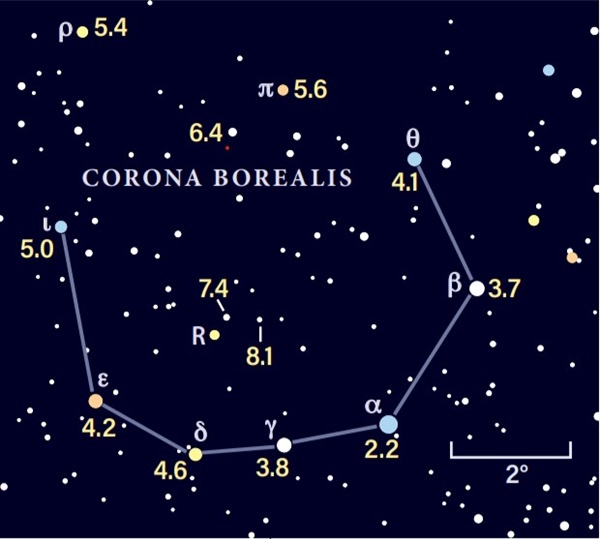
Friday, April 28
The Moon reaches apogee, the farthest point from Earth in its orbit, at 2:43 A.M. EDT. At that time, our satellite will sit 251,220 miles (404,300 km) away. The Moon now sits in Leo, just west of the Sickle asterism we observed earlier in the week.
On the other side of the sky, in the east, the curved form of Corona Borealis is some 40° high by 10 P.M. Although this constellation is small, it’s relatively bright. Its alpha star, Alphecca, shines at magnitude 2.2. About 3° to its northeast is Beta (β) Coronae Borealis, also called Nusukan, at magnitude 3.7. From these two stars, you can follow the curve of the crown north of Beta and east of Alpha. Use the star chart above to locate Delta (δ) Coronae Borealis with binoculars or a telescope. From there, look 2° north to find reddish R Coronae Borealis, or R Cor Bor.
This (usually) 6th-magnitude star is a variable that changes quickly and unpredictably, sometimes brightening and sometimes fading far below its usual luminosity. The chart at right lists the magnitudes of the other stars around it — compare R Cor Bor to its neighbors to see what magnitude it appears tonight when you observe it.
Sunrise: 6:04 A.M.
Sunset: 7:52 P.M.
Moonrise: 12:48 P.M.
Moonset: 3:01 A.M.
Moon Phase: Waxing gibbous (58%)


